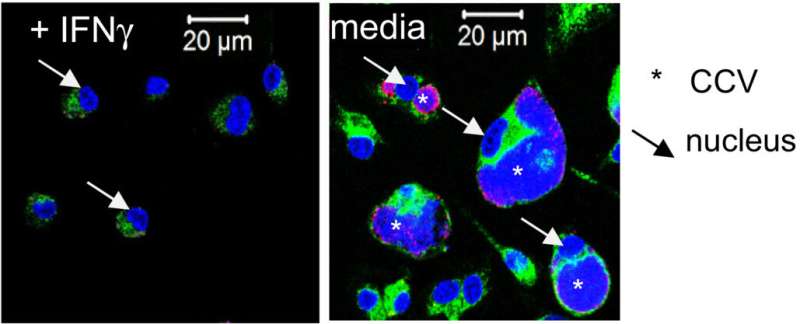This article has been reviewed according to Science X's editorial process and policies. Editors have highlighted the following attributes while ensuring the content's credibility:
fact-checked
peer-reviewed publication
trusted source
proofread
How macrophages use metabolic product to combat Q fever pathogen

Q fever can lead to pneumonia, and can attack several organs at once if it becomes chronic. Treatment with antibiotics is lengthy and only has limited success. But which factors in our immune system protect against chronic Q fever? This has now been investigated by researchers at FAU and Universitätsklinikum Erlangen, who have discovered a metabolic product that inhibits the reproduction of the pathogen.
The bacterium Coxiella burnetti predominantly affects sheep and goats, where it is found in a high concentration in the placenta and is released during lambing. If people inhale the bacterium, it can trigger severe pneumonia, known as acute Q fever. Outbreaks of Q fever occur every now and again, with the largest one to date being in the Netherlands between 2007 and 2010, when more than 4,000 people fell ill.
How does our immune system protect us from chronic Q fever?
The bacteria multiply in the macrophages, which are an important component in our immune systems where they destroy intruders such as viruses or bacteria. Usually, the immune system kills the bacteria and resolves the immune reaction within a matter of weeks. Some patients, however, develop a chronic form of Q fever that attacks various organs, in particular the inner lining of the heart and the vascular system.
Treatment involves extended courses of antibiotics, but success is by no means guaranteed. Until now, it has not been fully understood which immunological factors provide protection against chronic Q fever.
Metabolic product itaconate inhibits the growth of Coxiella burnetii
In research recently published in the journal EMBO Molecular Medicine, the working group led by Prof. Dr. Roland Lang together with the working group led by Prof. Dr. Anja Lührmann, both from the Institute of Microbiology—Clinical Microbiology, Immunology and Hygiene at Universitätsklinikum Erlangen, proved that production of the metabolic product itaconate by infected macrophages represented a significant defense mechanism against Coxiella burnetii.
Analysis of macrophages in mouse models indicated that after an infection with Coxiella burnetii they produced a particular enzyme (aconitate decarboxylase 1, or ACOD1 for short), that then triggered the production of itaconate. If the macrophages lack the ACOD1 gene required to produce the enzyme, no itaconate is produced and Coxiella burnetii can reproduce unchecked.
Adding itaconate to macrophages in vitro and treating infected mice lacking the ACOD1 gene with itaconate brought bacterial growth under control. In a bacterial culture, itaconate was demonstrated to directly inhibit the growth of Coxiella burnetii.
Interestingly, compared to mice, human macrophages produced considerably smaller quantities of itaconate, and allowed Coxiella burnetii to continue to grow. However, treatment using itaconate also inhibited the reproduction of bacteria in humans.
"Our results show that due to the limited treatment options currently available using antibiotics, the ACOD1-itaconate pathway could be an interesting candidate for new approaches to treating chronic Q fever," explains principal investigator Prof. Dr. Roland Lang.
More information: Lisa Kohl et al, Macrophages inhibit Coxiella burnetii by the ACOD1 ‐itaconate pathway for containment of Q fever, EMBO Molecular Medicine (2022). DOI: 10.15252/emmm.202215931

















